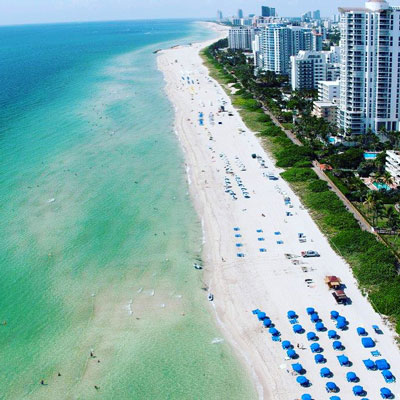
The City of Miami Beach is a barrier island community located in southeast Florida between Biscayne Bay and the Atlantic Ocean with over seven miles of white, sandy beaches. The City’s beaches are a critical economic, recreational, environmental, storm protection, and erosion control asset for the City of Miami Beach, Miami-Dade County, and the State of Florida. Last year, they attracted approximately 7 million overnight visitors to Miami Beach which spent $11.4 billion. The beaches also serve as the first line of defense in protecting over $46 billion in taxable property value in Miami Beach against storm surges and sea level rise.
The City of Miami Beach and Miami-Dade County collaborate to restore and enhance existing habitats on the beaches. Management activities across the City and the County are coordinated by the city’s Environment and Sustainability staff. Other City Departments that are involved include the Property Management Division, the Tourism, Cultural, and Economic Development Department, and the Sanitation Division. The City spends an estimated $212 million on beach management and beach-related activities. Additionally, Miami-Dade County’s Beach Operations spends approximately $2 million on beach maintenance activities in Miami Beach, not including the cost of beach renourishment or other related projects which vary annually.
- The southern portion of Allison Park will be inaccessible during the project.
- The U.S. Army Corps will use Allison Park as a staging area for the project and occupy 22 parking spaces at the southern end of the parking lot.
- This staging area will be used to house office trailers, generators, roll-off containers, and other construction equipment or materials.
- Work in the staging area can occur from 6 a.m. to 11 p.m. Work on the beach will be limited from 7 a.m. or sunrise (whichever is later) through 7 p.m. or sunset (whichever is earlier). The contractor will work weekdays and weekends, as needed.
- A portion of the beach walk pavers adjacent to Allison Park will be removed to allow for the delivery of sand to the beach and pedestrian checkpoints will be in place.
- Moderate levels of construction noise are expected during the day.
- Construction equipment, machinery, and workers will be present in the work zone.
- Sections of the beach undergoing active construction will be closed to ensure public safety.
Beach Renourishment PPT 100721_FINAL_Rev3
A recording of the public meeting can be found here.
LTC 409-2021 Miami-Dade County Beach Erosion Control and Hurricane Protection Project Update
Please visit the USACE website for more information on this project.
The U.S. Army Corps of Engineers has released the publication of the Draft Integrated Feasibility Report and Environmental Assessment for the Miami-Dade County, Florida, Coastal Storm Risk Management Study. The four-year, $3 million study considers the feasibility of implementing engineering alternatives to manage coastal storm risks along the Atlantic Ocean shoreline in Miami-Dade County, Florida, over a 50-year period. Federal participation in the existing federal beach nourishment project, initially constructed between 1975 and 1982, will expire in 2025.
The study’s tentatively selected plan proposes periodic beach nourishment in certain locations of Miami Beach. Sand for beach nourishments would come from a range of sand sources including the Baker’s Haulover Inlet Complex, accretional beach and nearshore areas in South Beach, offshore sand sources, and upland sand mines.
A milestone meeting will be held in August 2023 with the Office of the Assistant Secretary of the Army for Civil Works to determine if the feasibility study will continue for an additional four years through 2027. The purpose of the milestone meeting will be to evaluate the progress on plan formulation, ensure continued alignment of objectives between the NAO and Miami-Dade County, and to verify the scope and schedule for completion.
If the feasibility study is approved to continue in August 2023, the study would extend by sixty months and federal funding for the study would increase up to $8.2 million.
The U.S. Army Corps of Engineers Norfolk, VA District will host a pair of online public meetings in June. The public is invited to learn more about the study and its findings at the virtual sessions, scheduled for June 9th from 5-7pm and June 11th from 1-3pm. Community members may also contact study personnel during virtual office hours on June 12th from 1-2pm and June 18th from 5-6pm.
The public meetings follow release of the Miami-Dade Back Bay Coastal Storm Risk Management Draft Integrated Feasibility Report and Programmatic Environmental Impact Statement, which is available here.
The City can be copied on public emails via email at sustainability@miamibeachfl.gov.
For more information about Corps projects, please visit www.saj.usace.army.mil.
Miami-Dade County CSRM February 10, 2023 Meeting
Miami-Dade County CSRM Draft Feasibility Study
LTC 502-2021 Miami-Dade County Coastal Storm Risk Management Study
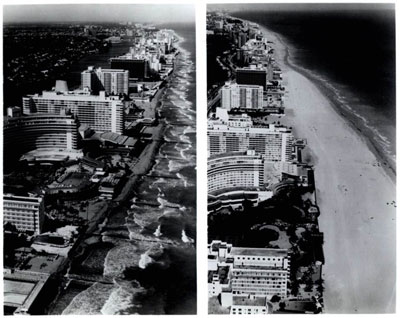 Beaches are living environments that are constantly changing. Fluctuations in seasons and weather can affect the overall structure of shorelines. This can mean that the sand that you see today, may not be there tomorrow.
Beaches are living environments that are constantly changing. Fluctuations in seasons and weather can affect the overall structure of shorelines. This can mean that the sand that you see today, may not be there tomorrow.
Strong waves, tidal currents, or winds that result from storms, flooding or even sea level rise remove sand, sediments and sometimes coastal dunes, changing the shape of the shoreline. For example, a beach can lose width or height over time as a consequence of sand being washed away.
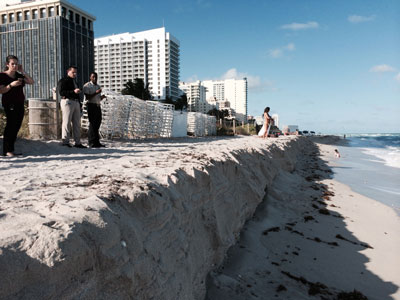 In 2015, a progressive step was taken towards ensuring that our beaches are properly protected and restored. The South Florida Mayor’s Beach Alliance was created, uniting mayors of Miami-Dade County’s five coastal municipalities. Through the Alliance, the mayors of Miami Beach, Surfside, Sunny Isles Beach, Key Biscayne and Bal Harbour signed a proclamation continuously urging the county, state and federal government to develop long-term solutions to restore beaches that have been impacted by erosion.
In 2015, a progressive step was taken towards ensuring that our beaches are properly protected and restored. The South Florida Mayor’s Beach Alliance was created, uniting mayors of Miami-Dade County’s five coastal municipalities. Through the Alliance, the mayors of Miami Beach, Surfside, Sunny Isles Beach, Key Biscayne and Bal Harbour signed a proclamation continuously urging the county, state and federal government to develop long-term solutions to restore beaches that have been impacted by erosion.
As inhabitants of a beachside city, the value and importance beaches provide to the economy and overall quality of life is understood. Fortunately, the City of Miami Beach, Miami Dade County, and the U.S. Army Corp of Engineers (USACE) are collaborating to help keep our beaches healthy through beach renourishment and other erosion control measures.
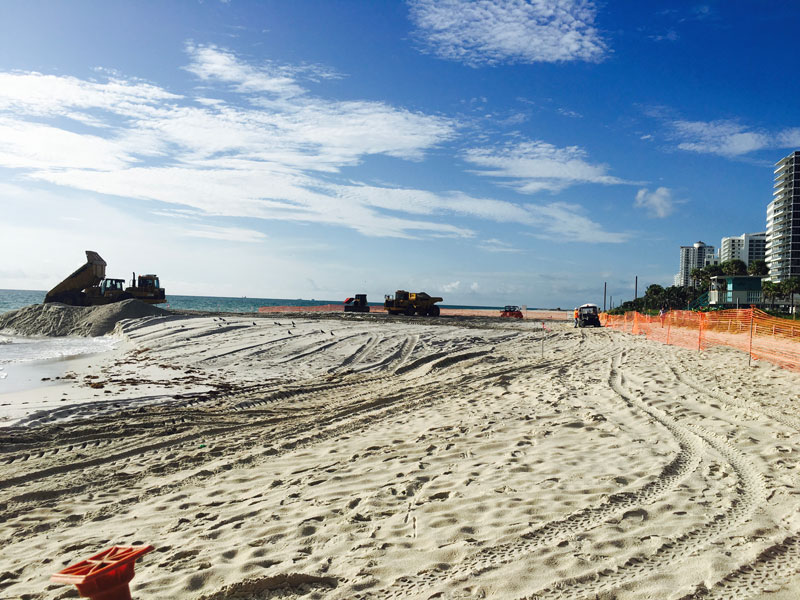
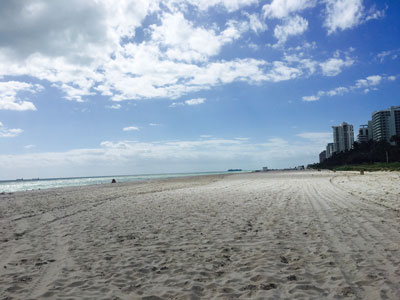 So what exactly do these methods normally entail? Beach renourishment is best explained as the strategic placement of sand on a beach that has experienced significant erosional activity. The sand for these projects is normally taken from what are known as “borrow sites,” such as sand mines, coastal construction projects and offshore sand banks.
So what exactly do these methods normally entail? Beach renourishment is best explained as the strategic placement of sand on a beach that has experienced significant erosional activity. The sand for these projects is normally taken from what are known as “borrow sites,” such as sand mines, coastal construction projects and offshore sand banks.
While sources of sand can vary from project to project, all sources are required to undergo testing to ensure they are beach compatible and that they meet necessary requirements in terms of safety, quality and sand characteristics such as grain size and color. The material must be approved by the city, the county and the state before it can be placed on the beach.
Beach renourishment is critical in maintaining the city’s first line of defense against storms and the environmental benefits provided by our beaches, including habitat for threatened and endangered species. Similarly, it promotes the recreational and tourism opportunities for which Miami Beach is best known for.
The city is also preparing for the impacts of climate change and sea level rise. In the Miami Beach Resiliency Plan, which is currently being developed, the city is looking at resiliency on a regional scale and determining what coordinated effort will be required from stakeholders to protect, preserve and enhance our natural systems.
While beach renourishment is not the end-all solution to coastal erosion, proper planning over the short and long term will allow the region to minimize its effects as much as possible. The ongoing installation and maintenance of the dune systems serve as a buffer between storm surge and other environmental factors. Other natural solutions include preserving coral reefs. These marine habitats are an important element in helping to keep a great portion of beaches in their place by fortifying the shorelines and preventing erosion.
The City of Miami Beach and Miami-Dade County collaborate to restore and enhance existing habitats on the beaches. Management activities across the City and the County are coordinated by the city’s Environment and Sustainability staff. Other City Departments that are involved include the Property Management Division, the Tourism, Cultural, and Economic
Development Department, and the Sanitation Division. The City spends an estimated $212 million on beach management and beach-related activities. Additionally, Miami-Dade County’s Beach Operations spends approximately $2 million on beach maintenance activities in Miami Beach, not including the cost of beach renourishment or other related projects which vary annually.
The City of Miami Beach is responsible for overseeing the compliance of beach concession operations, special events, and other permitted activities that take place. The City is also responsible for repairing and maintaining beach equipment installed by the City, including dune rope and post, sand fencing, lifeguard stands signage, swim ropes, and other similar items.
Miami-Dade County provides is responsible for daily sand sifting, litter clean-up on the beach and in dunes, waste management, and other similar maintenance activities. As an exception, the City’s Sanitation Division is responsible for waste management on the west end of beach entrances and for the cleanliness of the dunes in areas adjacent to completed beachwalk projects.
The Division of Environmental Resources Management (“DERM”) of Miami-Dade County’s Department of Regulatory of Economic Resources works with the US Army Corps of Engineers and the City to periodically renourish beaches that have been impacted by erosion. Historically these projects have been funded through a cost-share comprised of Federal, State and Miami-Dade County funds.
The Florida Department of Environmental Protection (FDEP) is responsible for permitting all temporary and permanent construction on the Property, including the construction of the beachwalk projects, restoration of the dune system and other similar activities. They are also responsible for reviewing and approving special events that require a variance to FDEP regulations.
Beaches are maintained on a daily basis in a conjoined effort between Miami-Dade County and the City of Miami Beach. The cleanliness of the beaches is an important factor that not only helps protect our primary tourist attraction but also helps maintain the health of our environment. The city’s beaches currently have 358 trash cans throughout its entire coastline and 100 recycling trash cans from approximately Government Cut to 46 Street. The county provides a recycling collection for all patrons and beachgoers.
Pilot Program:
In 2016, the City of Miami Beach and Miami-Dade County created a beach recycling agreement that outlines efforts that can help with improving recycling within the city’s beaches. This includes the initiation of a recycling bin pilot program. The proposed bins will have lids that are expected to not only increase recycling rates but decrease the amount of contamination within the bins.
Wraps for both trash and recycling bins on the beach:




As we continue the program, both the county and city will assess the pilot program for the recycling contamination, the ability of existing recycling contractors to obtain additional bins and/or larger ones for pick-up and increased operating time and cost. At the conclusion of one year, a report will be submitted by Miami-Dade County indicating the findings of this pilot program.
In Miami Beach, seaweed, more appropriately known as Sargassum, is a class of brown algae that floats on the ocean’s surface due to gas-filled berry-sized sacs called pneumatocysts. Sargassum is a very common alga in the ocean that can form large floating masses due to currents, winds, and other weather variances.
Sargassum provides a community on the ocean’s surface, creating shelter, nursery, feeding, and breeding grounds for a wide variety of marine life such as marine birds, crabs, fish, sea turtles, and shrimp. Sargassum is often considered a type of ecosystem engineer. It is of high ecological importance which makes it an essential part of marine ecosystems. Once it washes up on shore, it takes on another role to benefit coastal systems by providing nutrients to dune vegetation while also aiding in shoreline stabilization and beach nourishment.
During times of excessive accumulation, depending on the daily conditions, Miami-Dade County contractor crews may operate daily to collect and dispose of as well as cut and turn the buildup of seaweed on the water line across our 7-mile beach. Removals are performed from 22 – 32 streets and to the jetty north of Government Cut, which have been identified as hotspots (areas with excessive accumulation). Prior to operating heavy machinery, a team surveys for sea turtle nests each morning. Once the survey is complete, beach operations crews proceed to clean the beach until sunset, regardless of tidal conditions
For public health concerns with respect to sargassum, please visit https://stjohns.floridahealth.gov/_files/_documents/sargassum-informational-update-v2.pdf
Check out the factsheet below and read through the frequently asked questions on Sargassum:
Coastal dunes are habitats for wildlife and support a high biodiversity of flora and fauna. They also keep beaches healthy by accreting sand and minimizing beach erosion rates. The dunes protect coastal infrastructure and upland properties from storm damage by blocking storm surge and absorbing wave energy. A healthy dune system is an invaluable asset to coastal communities like Miami Beach.
Native salt-resistant vegetation is a key component of a healthy dune system. Their stems trap and accumulate wind-blown sand, building up the dune and creating a sand reservoir for the system. Their roots stabilize the accumulated sand and significantly minimize erosion during high tides and storms. Additionally, during storms, the vegetation absorbs wave energy, blocks storm surge, and protects coastal infrastructure. Therefore, the long-term success of the beach and the upland properties is dependent on the health of the City’s dune system.
The Environment & Sustainability Department’s Environmental Resources Division manages the City’s interest in Beach Renourishment and the Dune Management Plan. The 4th amendment to the RDA Interlocal Agreement with Miami Dade County included a requirement that the City set aside $1.5 million (for each of the six years outlined in the agreement) to help fund county-led beach renourishment. The County provided the City $75,000 to fund a dune enhancement study that will be completed in FY 2023 and $300,000 match for a $1 million Resilient Florida grant for dune restoration.
The Department received another Resilient Florida grant for $454,000 to conduct the City’s Vulnerability Assessment and an Adaptation Plan. This project will analyze the risk of all City assets to flooding and sea level rise and will produce a comprehensive plan to address the risks
Learn more here: http://www.mbrisingabove.com/climate-mitigation/natural-resources/dunes/
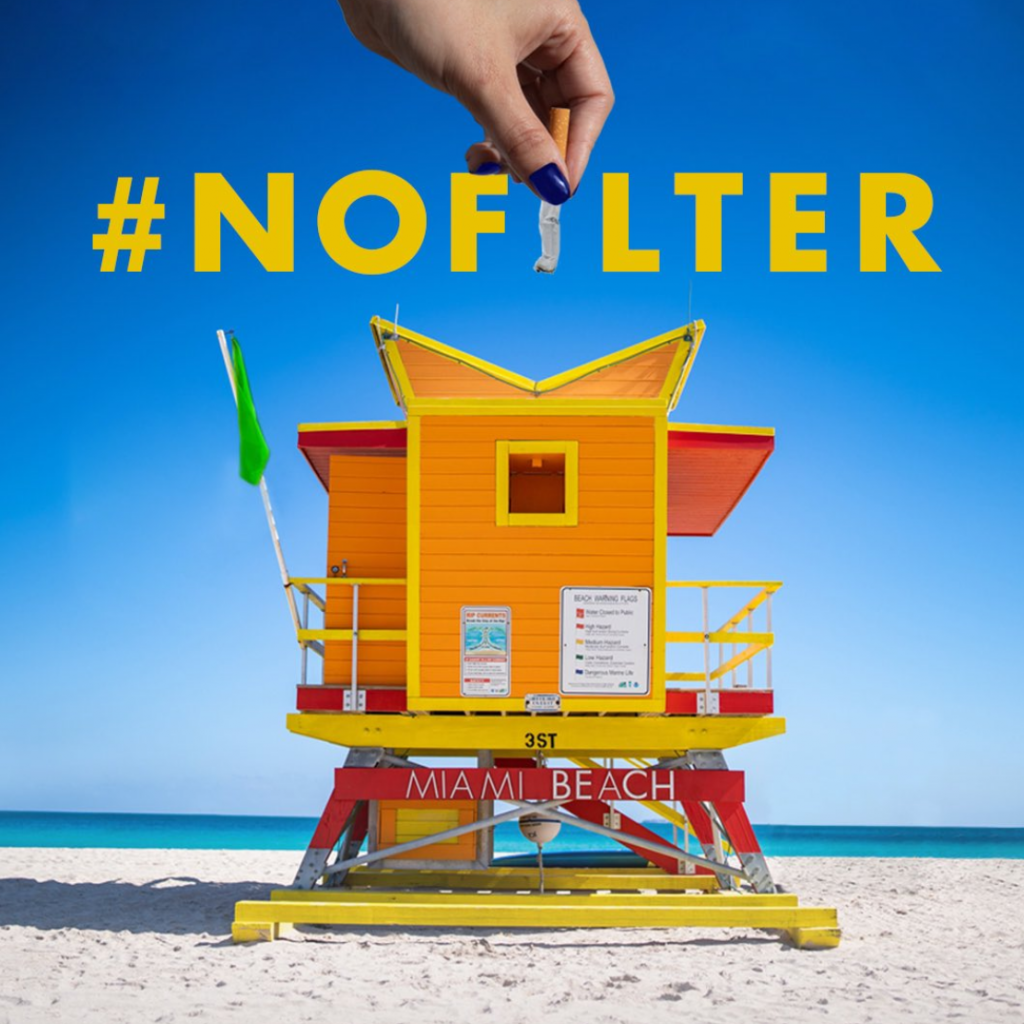 Residents and visitors coming to our beaches seek areas that are smoke-free. Second-hand smoke from tobacco is a health risk and can be offensive to others. Additionally, the discarded components of cigarettes are toxic to wildlife, waterways, and beaches.
Residents and visitors coming to our beaches seek areas that are smoke-free. Second-hand smoke from tobacco is a health risk and can be offensive to others. Additionally, the discarded components of cigarettes are toxic to wildlife, waterways, and beaches.
Citing health and environmental benefits, the Miami Beach City Commission adopted Ordinance 2022-4509 to ban cigarette smoking and other tobacco products on the city’s public beaches and public parks.
Ordinance 2022-4509 - Smoking in Parks and on the Beaches Is Prohibited
Cigarette filters, more commonly known as cigarette butts, are one of the largest pollutants found on the sand. An estimated 1.7 billion pounds accumulate in the natural environment on an annual basis. A common misconception of cigarette butts is that they are composed of materials with biodegradable qualities. In actuality, cigarette filters are comprised of cellulose acetate, a fibrous plastic that can take anywhere between 5-10 years to completely biodegrade. Discarded cigarette butts can be carried as runoff from streets to drains, to canals, and eventually to the ocean. Those that are disposed of on the beach are often washed away directly into the ocean by incoming waves. These filters then become hazardous to marine organisms which often confuse it as being edible.
Cigarette filters are the single most collected item during beach cleanups each year. They are an environmental blight on streets, sidewalks, and other open areas.

